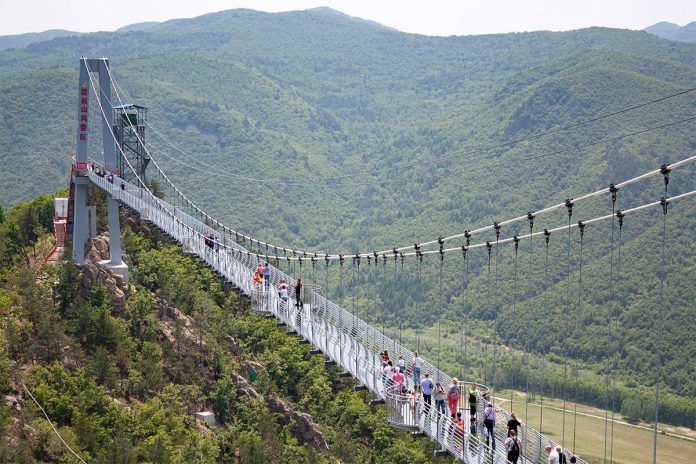[ad_1]

The undamaged glass bridge in Longjing, China
GZMKS/Getty Images
High winds are reported to have broken a glass-bottomed bridge in China, leaving a man clinging to a handrail above a 91-metre drop. Authorities claim that the bridge outside the city of Longjing was struck by winds of up to 150 kilometres per hour.
With similar glass-bottomed tourist attractions becoming more common around the world, from Tower Bridge in London to the Grand Canyon Skywalk in Arizona, should people be concerned about safety?
Advertisement
Paul Bingham, a materials scientist at Sheffield Hallam University, UK, says he would have no qualms about walking on one – as long as it wasn’t during 150-kilometre-per-hour wind. “Designers and architects need to think carefully before speccing these materials, but I don’t think people should be worried,” he says.
Bingham says that glass has two weaknesses as a building material. “The first is that glass is inherently brittle,” he says. “The second is that glass doesn’t have crystals, so once a crack on the surface starts to propagate, there’s very little to stop it.”
A lot of research into glassmaking is focused on how to reduce the amount of surface flaws, says Bingham. “If you’ve got a scratched surface, the glass is much weaker than if the surface is pristine and hasn’t had contact with dust or the atmosphere.”
There are a number of techniques for creating extremely strong glass of the type probably used for the Longjing bridge. One is that modern glass is often coated with another material, such as a polymer, that protects it from flaws. These are developed to have the same refractive index as glass, so they don’t distort light rays passing through them and appear as a normal piece of glass. Many glass manufacturers can add laminates of flexible polymers between sheets of glass so that even if one layer does break the sheet stays intact.
Bingham says the glass on the bridge was likely to have had such a coating and laminations, but it would also have been toughened. This has two benefits: it makes the glass stronger, and when it does break, it tends to form harmless chunks rather than sharp shards.
Toughening essentially squashes the outer surfaces of the glass and stretches the interior. This can be done chemically, which involves dipping a sheet of glass in molten potassium nitrate, causing the sodium in the glass to migrate out into the molten material and the larger potassium atoms to migrate in. Or it can be done thermally, by rapidly cooling the surface of molten glass and allowing the inner section to cool more slowly. This compression effectively forces shut any tiny flaws and stops them propagating.
“It’s like trying to fill a washing machine with extra clothes when it’s already full,” says Bingham. “You can get them in but it creates a stress field. You’ve got to bash it a lot harder to break it.”
The collapse of a glass-bottomed bridge could theoretically be down to defects in the glass that could allow it to crack or for cracks to spread, says Bingham, but he thinks this is unlikely and he believes glass bridges are safe. It is far more probable in this case, he says, that the exceptionally high winds created strains that were too great for the glass of the bridge to handle while people were on it.
More on these topics:
[ad_2]
Source link











